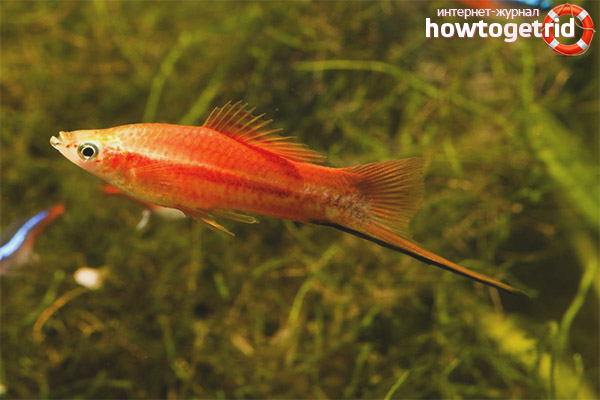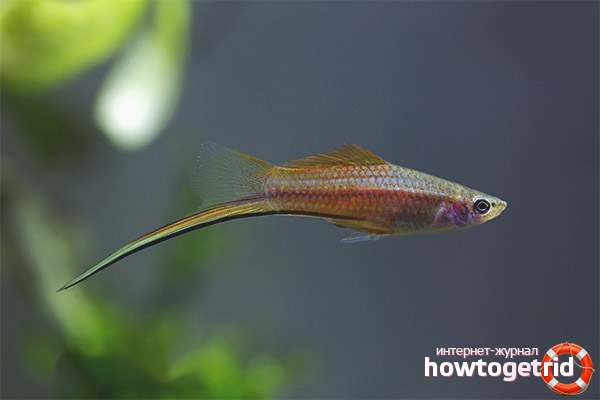The content of the article
The Sword-bearer is a rather famous scaly species, which got its bright name due to the presence of a special outgrowth on the fin. In external form, this outgrowth resembles a sword, which is why the fish became so called. To keep representatives of this species in aquariums began in the 19th century, and since that time they have not lost their popularity. Swordsmen love mainly for their interesting appearance and a variety of colors. In addition, these fish are not too demanding to the conditions of detention and quickly produce offspring.
Swordtails are peace-loving fish that easily get along with representatives of other species, so they are often lodged in common aquariums.However, it is important to remember that these are individuals that have different characters. Therefore, you can meet peaceful and quiet representatives, and you can buy a bully and a bully. This is especially true of males, as they usually behave more aggressively.
It is best to put the swordtails in a large spacious aquarium, which will have enough space for swimming, and at the same time, there will be a variety of plants. An excellent option would be a bone with floating plants. Such inclusions will serve as a tool for scattering light, which is very good for fry, as they will have shelter. Like most viviparous fish, swordtails are adapted to life in salt water, but this is not a requirement.
Life in the wild
Native places for swordmen are territories in Central America, located from the southern part of Mexico to Guatemala. In the reservoirs of these places you can find the original Sword, the color of which is less bright than those that have already been bred in aquariums.
Under natural conditions, the Sword bearer can be found in a wide variety of water bodies; they inhabit both standing water and running water. As a rule, small fishes of this species choose places for life that are well overgrown with plants.Here they have enough food in the form of algae, various insects and detritus.
Description of the species
In general, there are quite large varieties of swordtails. Males of this species can grow up to 11 centimeters in length, and females even up to 12. Fish of similar size reach in their natural habitat. In the aquarium, they are usually slightly smaller. The average life expectancy of such individuals is 4 years.
As for the exterior vila and color, in this case it is difficult to distinguish a certain group of colors, since the swordsmen are very diverse. The most popular are the red fish with a black tail in the form of a sword. There are also black, green, yellow, spotted fish and even albinos. It is rather difficult to describe their appearance, but almost everyone knows what a Swordsman looks like if he has seen an aquarium at least once in his life. So much these individuals are common today.
Requirements for the content in the aquarium
Sword-bearer is perhaps the most common type of fish in aquarists who are just starting their way in the breeding of scaly. These fish are convenient to maintain, as they are small, not too whimsical and demanding of the conditions provided and, moreover, are very easy to breed.Among the shortcomings of this species, we can distinguish the cockiness and pugnacity of some male swordtails.
How to feed the swordtails?
Swordtails - almost omnivorous fish. They can be treated with frozen food, cereal, live food and other types of pet food from the pet store. Like all representatives of the scaly, they need a special diet that will include a variety of foods. It is very important that in the diet of these fish were vegetable products with a large amount of fiber in the composition.
Under natural conditions, swordtails consume large amounts of thin algae and other fragile plants and fouling. It will be impossible to place the same large amount of algae in the aquarium, and it is extremely inconvenient, so you can use ready-made flakes made from plants as a substitute. You can even put these flakes in the basis of the menu, and live food to make only an addition to nutrition. Swordtails can be supplied with any live food, in this regard, the fish of this species are not demanding.
What care is required?
Swordtails - very unpretentious representatives of the fish, so keep them quite simple.For one fish will be enough capacity of 35 liters. However, it is worth noting that these are active fish, so if there is an opportunity to buy an aquarium more, it will not be superfluous. It is also important to remember that if you have a fish breeding goal, you should put one male in one aquarium and two or three females to it. If we take only one female, then the male can simply drive her or even bring her to death.
In one aquarium, it is better not to plant several males, as there is always a strict separation in the swordfish. For this reason, one of the males will drag the blanket over himself and chase the other males, which will inevitably lead to conflicts, clashes, fights and, as a result, injuries.
Swordtails are not particularly demanding for the temperature of the water in the aquarium. They are able to survive at 18 degrees, as well as at 28. The most suitable temperature will be from 23 to 25 degrees. Water hardness and acidity also do not greatly concern the Sword bearers, however, the most acceptable option is medium hard water and a pH level in the range from 6.8 to 7.8.
It is advisable to install filtration equipment in the aquarium with swordtails.It will be enough to use an internal filter. It is also very important to replace water every week with fresh water, about one fifth of the total volume. It should also be borne in mind that the Swordtails are good jumpers, so you should definitely cover the aquarium with something, otherwise if you don’t have people at home, you risk finding a dried fish body somewhere.
You can decorate the aquarium as you like, here everything depends on your preferences. The only thing, experts often recommend using plants as decorations. You can plant them quite thickly, as the swordtails are very fond of such a habitat. In addition, dense thickets allow females to hide from aggressive behavior of males.
With whom can swordtails coexist?

Older male swordtails are able to show aggression and even attack other species of fish. However, this behavior is individual. Some swordtails do become violent with age and periodically arrange fights in the aquarium, while some individuals, on the contrary, become quiet and calm.Increase aggression in males contribute to aquariums without plants. Absolutely you should not settle in the neighborhood of two or three males, if you do not want to observe the constant skirmishes.
Sword-bearers get along well with other viviparous fish, which include guppies, mollies and placiums. Also good are side by side swordfish with fish that spawn, namely with rainbow irons, scalars, neons and gourami. It is better not to place the goldfish with the Sword bearers, as they need lower temperature water, and in general the Sword bearers are rather restless neighbors for goldfish.
How to distinguish between males and females?
Quite often there are cases when the female turns into a male, having grown a sword on the fin. The most interesting thing is that the behavior of the female changes as well, she begins to behave as a representative of the stronger half and even cares for other females, however, it is infertile. At present, the reasons for this unusual phenomenon have not yet been clarified.
How does reproduction occur?
Sword-bearers are small fish belonging to live-grounders, therefore the process of fertilization of eggs takes place inside the body of the female, where she bears eggs until the moment of complete formation of the fry. After this, childbirth occurs and ready-made live fry are born. The gestation period lasts about a month.
Video: aquarium fish swordtail












To send